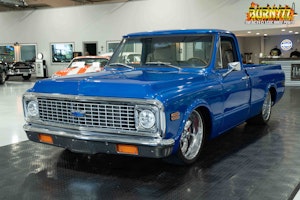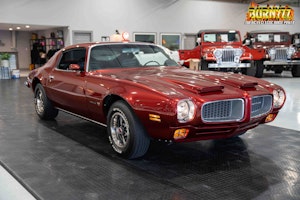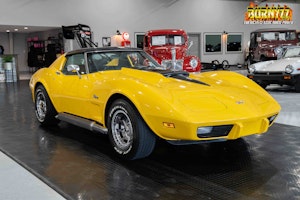Media | Articles
Never Stop Driving #100: The Best Driver’s Car?
Why aren’t engineers considered artists? That’s one question I have after watching Hagerty Media’s exclusive video review of the new Gordon Murray Automotive T.50 supercar, which we paired with the McLaren F1 that Murray designed more than three decades ago. Another question: How can I get my hands on $3 million to buy that T.50?
In stereo sound and vivid colors, the film illustrates why the T.50—designed and engineered by a team led by Gordon Murray—might just be worth a healthy retirement account. Murray has proven time and time again that he’s an automotive engineer of unrivaled creativity, passion, and brilliance. We’ve summarized some of his high points in this article. He deserves, however, his own multi-part documentary.
Gordon Murray started racing in his native South Africa before landing a job with the Brabham F1 team. Before he turned 30 years old, he was appointed chief designer and cars he designed won two F1 world championships. By the mid-Eighties, Murray moved to McLaren and led the team that engineered the MP4/4, the car that won 15 of 16 races in 1988. Soon after, Murray and McLaren debuted the F1 street car, which we had the privilege of driving for Hagerty Drivers Club magazine a few years ago with the assistance of none other than Jay Leno.
The F1’s headline figures include a 0-to-60-mph time of 3.3 seconds and a 240-mph top speed, but they’re not the real story. The F1 has been coveted since it debuted and is heralded as one of the best driver’s cars ever produced. That does, however, lead to the question, what exactly is a driver’s car?
Marketplace
Buy and sell classics with confidence
The answer is personal and subjective because a driver’s car is all about the feeling it gives the person behind the wheel. I’m told by those I trust who’ve driven the F1—I never have—that there’s a purity to the F1 experience. The driver’s seat is in the middle of the car and there’s a directness to the controls coupled with a howling BMW V-12 engine. The “system” delivers an experience that borders on religious for those of a certain type (count me as true to type).
According to the Hagerty Price Guide, a 1992 F1 is worth about $20 million, which makes it one of the most valuable cars produced in the last 50 years. Amazing. So, in 2018 when Gordon Murray announced that he would design and produce an F1 successor, the T.50, the car world went nuts. How could he improve on greatness?

In a Hagerty Media scoop, contributor Henry Catchpole assembled both cars, drove them on lovely roads in Spain, and explained the experience of these incredible machines. I won’t give away the ending here except to say that the lucky few who got on the T.50 list—they’re sold out—will not be disappointed. We’ve made this film and provided it free to spread the love and passion for driving. If you’d like to support our efforts, please join the Hagerty Drivers Club.
Back to my opening sentence: Is Gordon Murray not an artist? He builds cars not as tools, but machines that inspire emotional responses. His canvas is the road, and his supplies include metal and composites. I’d argue that the creativity to conjure a vision for a car, and to solve design challenges to realize the dream, are no different than the creativity a painter relies on when putting brush to canvas. I’m also fascinated that despite over 100 years of automotive engineering and ever more powerful computer tools, the talent of the human running the process, in this case Murray, remains the most critical element. Bravo! And thank you, Gordon!
Okay, after you watch the film, here’s a bunch of new material from Hagerty Media and beyond to keep you entertained and informed when you’re not out driving this holiday weekend (you’re driving, right?).
- The latest speedfest from Cammisa
- Barn Find Hunter Tom Cotter unearths a Datsun raced by Paul Newman
- A beginner’s guide to building your own Hemi Charger
- Rabbit GTI buyer’s guide
- The Andretti spurning by F1 saga gets weird: Senators demand investigation
Thanks for reading!
Larry
P.S.: Your feedback is very welcome. Comment below!
Please share this newsletter with your car-obsessed friends and encourage them to sign up for the free weekly email. The easy-to-complete form is here. And if you’d like to support the efforts of Hagerty Media, please consider joining the Hagerty Drivers Club.













As a career artist I think I can offer an answer as to why engineers are “not considered” artists. By the fine artist’s nature, they choose to more or less work with complete freedom. Whereas an engineer generally works within parameters, math, physics, rules, structure, etc. An artist might more likely design a car from the outside in, where an engineer more likely from the inside out. Most important though, both can be both. Meaning, there is no reason why an engineer can’t also be an accomplished artist using both mindsets. As important is the idea of collaboration. Many a great song was born when a great composer and a great lyricist worked together.
Hey that’s interesting. Thanks for sharing. There are always constraints, even with paint and canvas, right?
Larry, Your articles are something I always look forward to reading…
Thanks
@Tom: Couldn’t have said it better myself.
Re: F1 vs T.50: In a situation where, realistically, every word Mr Catchpole spoke could have easily been presented as the most profound thing ever said by human-kind – as some journalists have a proclivity for – Henry’s informative, measured presentation – punctuated with the perfect amount of emotion – actually enhanced the content, instead of detracting from it. It was definitely more “The Gordon Murray Show” with co-stars McLaren F1 and GMA T.50, than “The Henry Catchpole Show”.
It is unfortunate we will likely never see Mr. Murray turn his attention to the mass enthusiast market again as he did with his Rocket design of the early ‘90’s.
The term ‘artist ‘or ‘work of art’ is now frequently applied to just about anything that requires a modicum of creativity, from restomods to flower arrangements. Often if you say something doesn’t qualify as art ( we won’t delve into the old “what is art?” question) people will take offense as though it’s an insult rather than it being a comment saying it’s simply a different discipline.That is NOT to say that it makes it less valid or lacking quality. Countless artists have also worked in engineering ,architecture ,etc. So while there is an overlap even they would differentiate between their works. Gordon Murray is a great engineer . He deserves all the respect that one in such a difficult field should. So saying someone isn’t an artist isn’t to degrade them. You can also in a way qualify art by much the same standards. Taken to the extreme, would you bother to compare Poker Playing Dogs to Guernica? My room mate in school majored in photojournalism. When a girl said to him- “I’ve always admired artists.” -he simply replied – “I’m not an artist. I’m a photographer. ” – Well put I’ve always thought.
Engineering can be every bit as creative, innovative, and expressive as artistic work, and frankly we have need of engineers first and foremost.
I’d say we as a society should laud excellent engineering solutions as highly as we can.
The question of what is the best drivers car is a good one. No doubt the T.50 and F1 fit that bill and I agree that Gordan Murray is an artist, but so too are Pagani, Koenigsegg etc. It is less difficult, but not easy, to build the ‘ultimate’ drivers car when budget/price are non-issues. In my mind, the best drivers car is something that punches above its weight at its price point (maybe think of a smiles per dollar ratio). Porsche 356, early Lotus offerings, Mazda Miata etc, all fit that bill. When new, they could be had for a reasonable sum (the latter of those three still fits that bill and is relevant in the market of current offerings). I wish there were an objective way to measure smiles per dollar in a performance test, but like art, beauty is in the eye of the beholder. Nope…I won’t spend a million dollars on ‘art’ that consists of a banana duck taped to a canvas even if Andy Warhol or Pablo Picasso were the author. Given enough dough, I’ll bet even Ralph Nader might be able to produce a contender for the ‘best’ drivers car. Call me proletariat, but I’ll bet my bottle of Mondavi works better for me than a first cru Rothschild works for those one percenters that delude themselves into thinking that spending more coin equates to ‘the best’. I love that glorious BMW V-12 sound from a muffler deleted 3k junkyard rescue 750i…not too far off from that 20 million dollar BMW V-12 in the F1…smiles per dollar wins again in my book.
Great point. My NA Miatas never fail to make me smile…
As for what makes a great driver’s car, I think it largely comes down to things that are recognizable but difficult to quantify. How does one measure steering feel, or throttle response, or the way the brake pedal offers that perfect blend of firmness with progressive clamping force? How can you compare the way one car’s feedback through the control inputs and the chassis offers all the sensations you want while filtering out the really unpleasant stuff? How does one measure the perfect shifter or the clutch that seems telepathic?
Yet these are the things that make a perfect driver’s car in my eyes. It’s all about the experience of interacting with a machine that isn’t just competent, but seems to enjoy driving as much as the driver.
And frankly, I think the very best driver’s cars offer these things at relatively low speeds. Because most of them are being used on public roads by people who are not professionally trained racing drivers. The thrill of speed should be accessible without too much actual speed.
And to be truly impressive, they should be both well-made and accessible to everyone. Because it shouldn’t be all that difficult to make a great car for a six-figure price. To make something great for a low price is a bigger challenge, but it also opens the appreciation for driving to a wider audience.
Who in their right mind would buy an EV after watching this video!